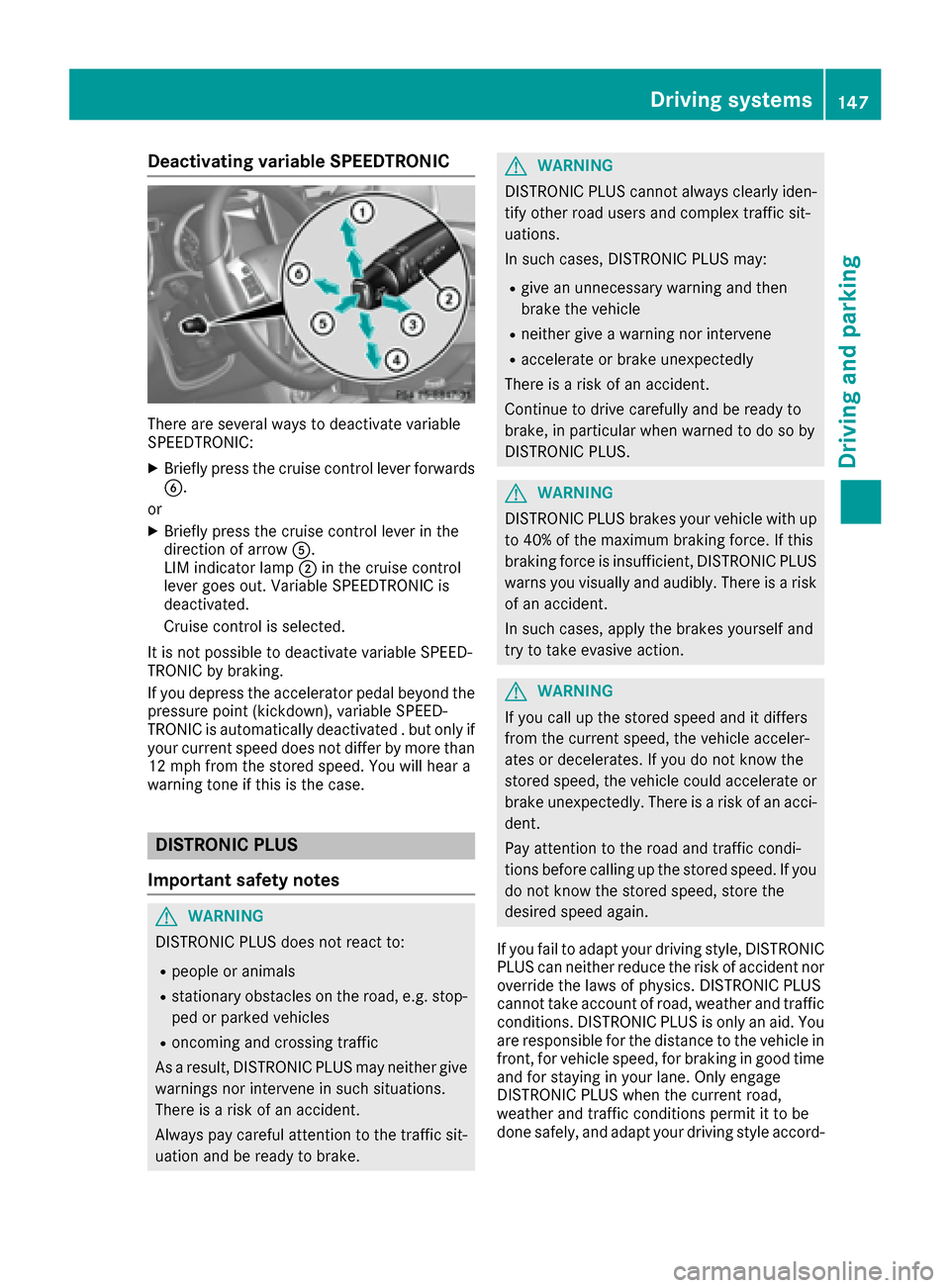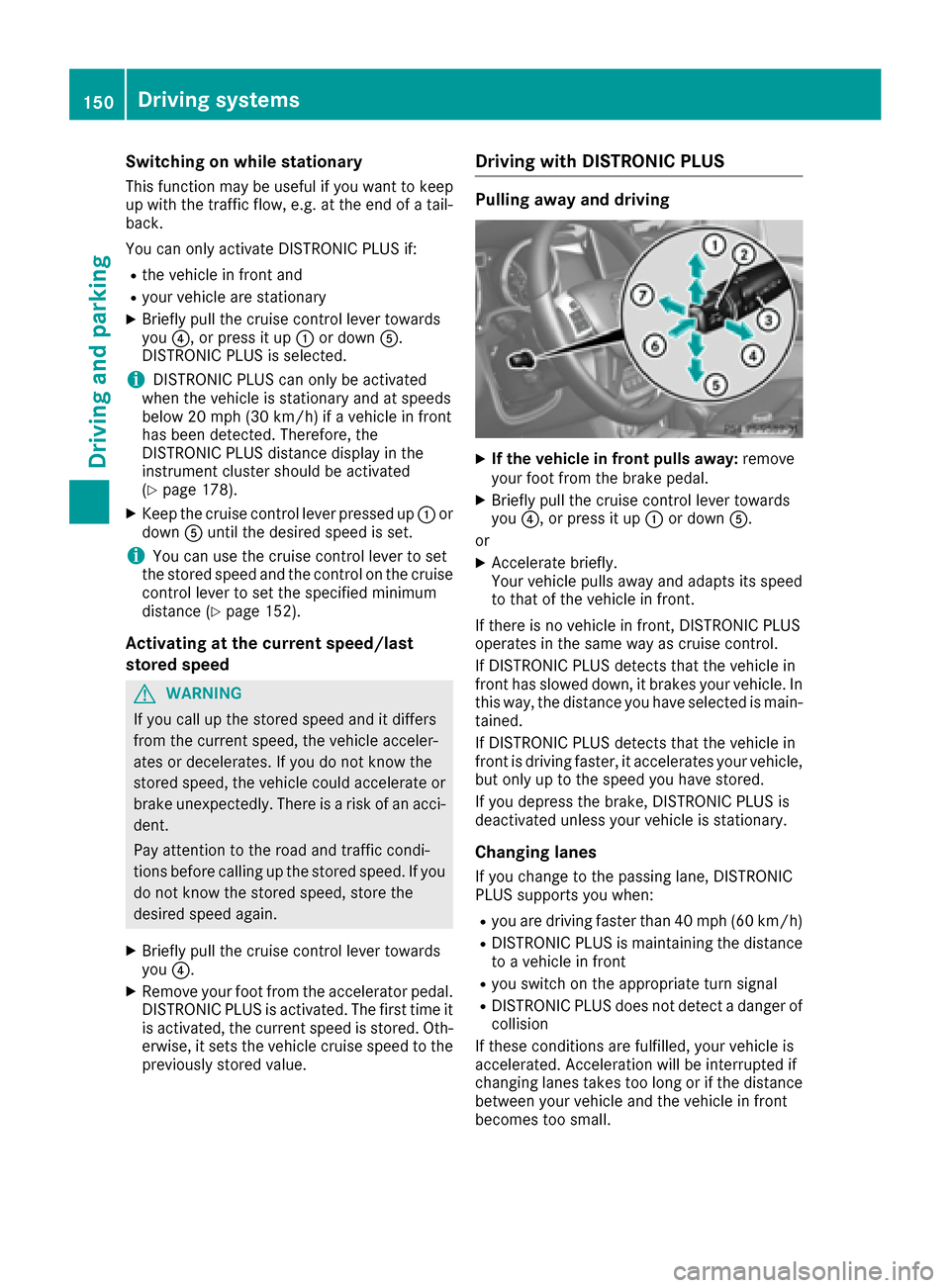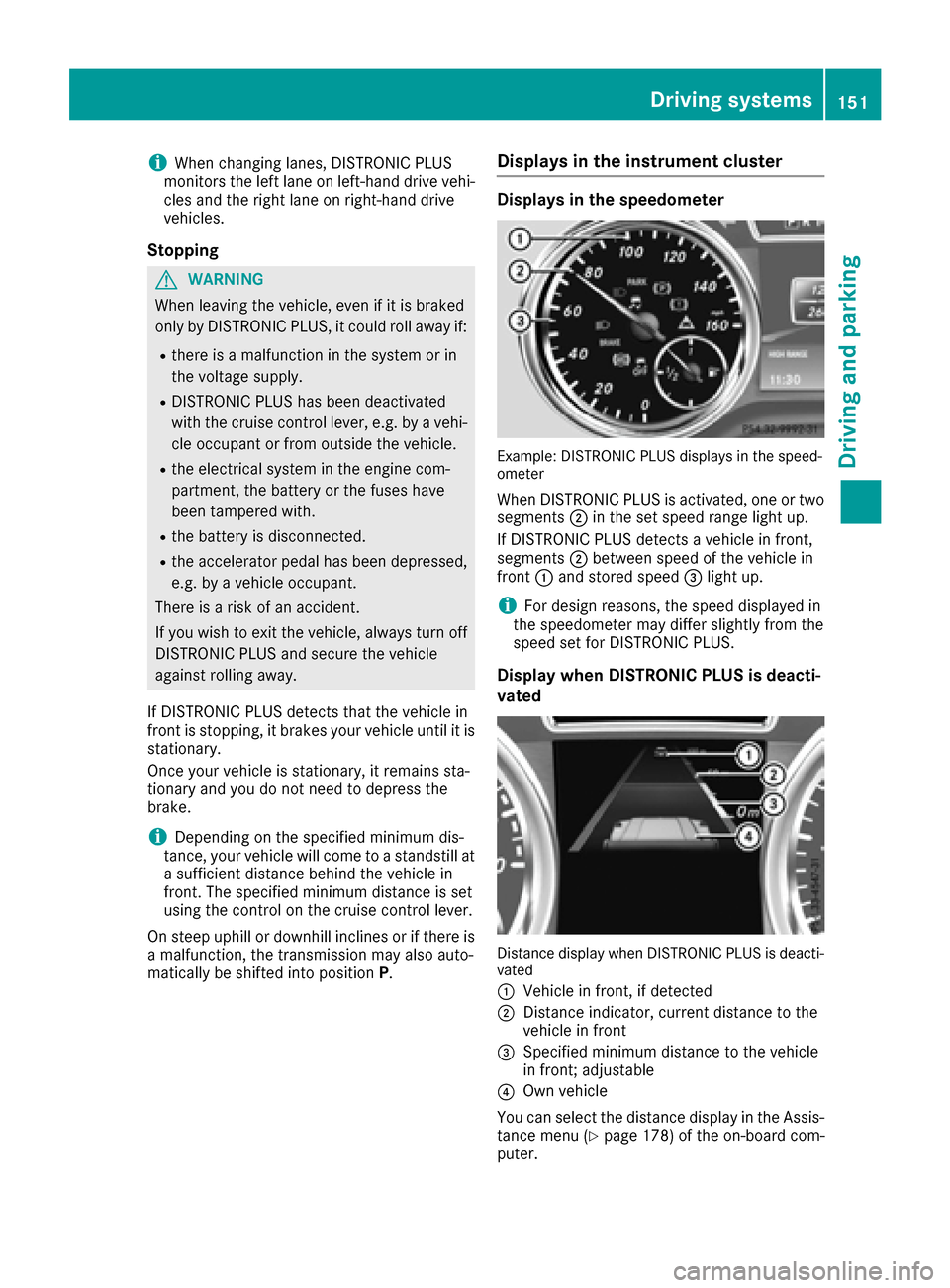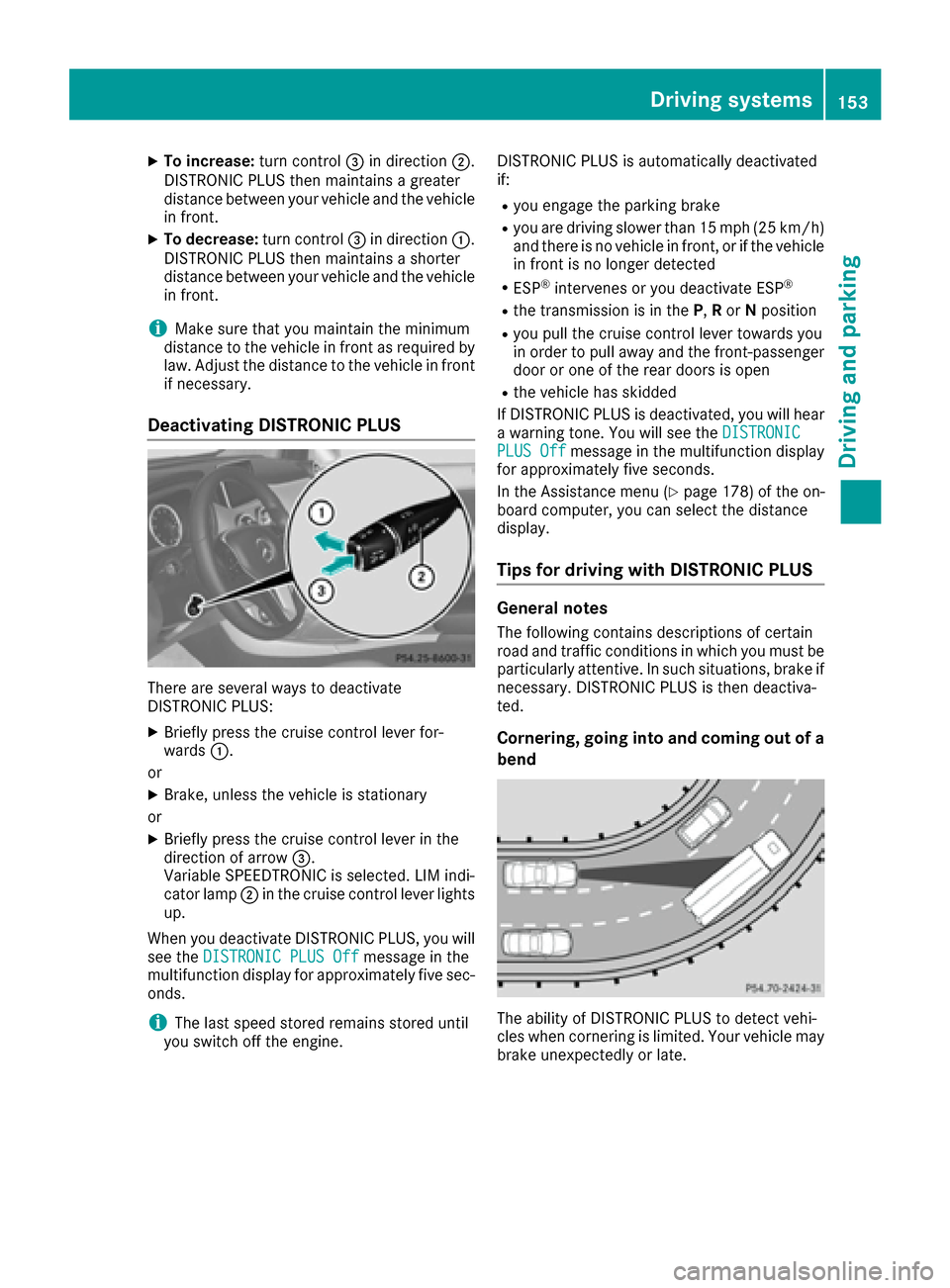2016 MERCEDES-BENZ G-Class warning
[x] Cancel search: warningPage 148 of 302

ATo switch between cruise control and varia-
ble SPEEDTRONIC
BTo deactivate cruise control
If you fail to adapt your driving style, SPEED-
TRONIC can neither reduce the risk of accident
nor override the laws of physics. SPEEDTRONIC
cannot take account of road, weather and traffic
conditions. SPEEDTRONIC is only an aid. You
are responsible for the distance to the vehicle in
front, for vehicle speed, for braking in good time
and for staying in lane. Only engage SPEED-
TRONIC when the current road, weather and
traffic conditions permit it to be done safely.
Drive carefully and maintain a suitable distance to the vehicle in front.
XCheck whether LIM indicator lamp ;is on.
If it is on, variable SPEEDTRONIC is already
selected.
If it is not, press the cruise control lever in the
direction of arrow A.
LIM indicator lamp ;in the cruise control
lever lights up. Variable SPEEDTRONIC is
selected.
Storing the current speed
:To activate or increase speed
;LIM indicator lamp
=To activate at the current speed/last stored speed
?To activate or reduce speed
ATo switch between cruise control and varia-
ble SPEEDTRONIC
BTo deactivate cruise control
You can use the cruise control lever to limit the speed to any speed above 18 mph while the
engine is running.
XBriefly press the cruise control lever up :or
down ?.
The current speed is stored and shown in the
multifunction display.
Calling up the last speed stored
:To activate or increase speed
;LIM indicator lamp
=To activate at the current speed/last stored speed
?To activate or reduce speed
ATo switch between cruise control and varia-
ble SPEEDTRONIC
BTo deactivate cruise control
If you fail to adapt your driving style, SPEED-
TRONIC can neither reduce the risk of accident
nor override the laws of physics. SPEEDTRONIC
cannot take account of road, weather and traffic
conditions. SPEEDTRONIC is only an aid. You
are responsible for the distance to the vehicle in
front, for vehicle speed, for braking in good time
and for staying in your lane. Only activate
SPEEDTRONIC when the prevailing road,
weather and traffic conditions permit. Drive
carefully and maintain a suitable distance to the
vehicle in front.
XBriefly pull the cruise control lever towards
you =.
iIf you call up the stored speed and your cur-
rent speed is higher, you will hear a warning
tone. You will see the Limit Exceeded
mes-
sage in the multifunction display.
iIf no speed is stored, variable SPEED-
TRONIC stores the current speed and main-
tains it.
146Driving systems
Driving and parking
Page 149 of 302

Deactivating variable SPEEDTRONIC
There are severalways to deactivat evariable
SPEEDTRONIC:
XBriefly press th ecruise contro llever forwards
B.
or
XBriefly press th ecruise contro llever in th e
direction of arrow A.
LI M indicator lamp ;in th ecruise contro l
lever goe sout .Variable SPEEDTRONIC is
deactivated.
Cruise contro lis selected.
It is no tpossible to deactivat evariable SPEED-
TRONIC by braking .
If you depress th eaccelerator peda lbeyond th e
pressure poin t(kickdown), variable SPEED-
TRONIC is automatically deactivated .but only if
your curren tspeed doe sno tdiffe rby more than
12 mph from th estored speed. You will hear a
warnin gtone if this is th ecase.
DISTRONI CPLUS
Important safet ynotes
GWARNING
DISTRONIC PLU Sdoe sno treact to :
Rpeople or animals
Rstationary obstacles on th eroad, e.g. stop-
ped or parke dvehicles
Roncomin gand crossin gtraffic
As aresult ,DISTRONIC PLU Smay neither giv e
warnings no rinterven ein suc hsituations.
There is aris kof an accident.
Always pay careful attention to th etraffic sit -
uation and be ready to brake .
GWARNING
DISTRONIC PLU Scanno talways clearly iden -
tify other road user sand complex traffic sit -
uations.
In suc hcases, DISTRONIC PLU Smay:
Rgiv ean unnecessary warnin gand then
brake th evehicle
Rneither giv e awarnin gno rinterven e
Raccelerat eor brake unexpectedly
There is aris kof an accident.
Continue to drive carefully and be ready to
brake ,in particular when warned to do so by
DISTRONIC PLUS.
GWARNING
DISTRONIC PLU Sbrake syour vehicle wit hup
to 40 %of th emaximum braking force. If this
braking forc eis insufficient, DISTRONIC PLU S
warn syou visually and audibly. There is aris k
of an accident.
In suc hcases, apply th ebrake syoursel fand
tr y to take evasiv eaction .
GWARNING
If you cal lup th estored speed and it differs
from th ecurren tspeed, th evehicle acceler -
ates or decelerates. If you do no tknow th e
stored speed, th evehicle could accelerat eor
brake unexpectedly. There is aris kof an acci-
dent.
Pay attention to th eroad and traffic condi-
tion sbefor ecallin gup th estored speed. If you
do no tknow th estored speed, stor eth e
desire dspeed again .
If you fail to adapt your drivin gstyle, DISTRONIC
PLU Scan neither reduce th eris kof acciden tno r
override th elaws of physics. DISTRONIC PLU S
canno ttake accoun tof road, weather and traffic
conditions. DISTRONIC PLU Sis only an aid. You
are responsible fo rth edistanc eto th evehicle in
front, fo rvehicle speed, fo rbraking in goo dtime
and fo rstayin gin your lane. Only engage
DISTRONIC PLU Swhen th ecurren troad,
weather and traffic condition spermit it to be
don esafely, and adapt your drivin gstyle accord-
Driving systems14 7
Driving an d parking
Z
Page 150 of 302

ingly. Drive carefully and maintain a suitable dis-
tance to the vehicle in front.
When DISTRONIC PLUS detects a risk of colli-
sion with the vehicle in front but is unable to
sufficiently decelerate the vehicle in order to
maintain the set distance from the vehicle in
front, you will be warned visually and acousti-
cally. DISTRONIC PLUS cannot prevent a colli-
sion without your intervention. An intermittent
warning tone will then sound and the distance
warning lamp will light up in the instrument clus-
ter. Brake immediately in order to increase the
distance from the vehicle in front, or take eva-
sive action, provided it is safe to do so.
DISTRONIC PLUS may not detect narrow vehi-
cles driving in front, e.g. motorcycles, or vehi-
cles driving on a different line. Therefore, always
pay attention to traffic conditions even when
DISTRONIC PLUS is activated. Otherwise, you
may fail to recognize dangers in time, cause an
accident and injure yourself and others.
In particular, the detection of obstacles can be
impaired if:
Rthe sensor is dirty or covered
Rthere is snow or heavy rain
Rthere is interference by other radar sources
Rthere is the possibility of strong radar reflec-
tions, for example, in parking garages.
If DISTRONIC PLUS is activated, the vehicle
brakes automatically in certain situations. This
can happen unexpectedly, especially when tow-
ing or in a car wash. There is a risk of an acci-
dent. In these or similar situations, deactivate
DISTRONIC PLUS.
If you want DISTRONIC PLUS to assist you, the
following activation condit
ions must be fulfilled
(Ypage 149) and the radar sensor system must
be operational.
General notes
DISTRONIC PLUS regulates the speed and auto- matically helps you maintain the distance to the
vehicle detected in front. DISTRONIC PLUS
brakes automatically so that the set speed is not
exceeded.
On long and steep downhill gradients, especially
if the vehicle is laden or towing a trailer, you
must select shift range 1,2or 3in good time. By
doing so, you will make use of the braking effect
of the engine. This relieves the load on the brake
system and prevents the brakes from overheat-
ing and wearing too quickly. If DISTRONIC PLUS detects a slower-moving
vehicle in front, your vehicle is braked in order to
maintain the preset distance to the vehicle in
front.
If there is no vehicle in front, DISTRONIC PLUS
operates in the same way as cruise control in the
speed range between 20 mph (Canada:
30 km/h) and 120 mph (Canada: 200 km/h). If
a vehicle is driving in front of you, it operates in
the speed range between 0 mph (0 km/h) and
120 mph (Canada: 200 km/h).
Do not use DISTRONIC PLUS while driving on
roads with steep gradients.
As DISTRONIC PLUS transmits radar waves, it
can resemble the radar detectors of the respon-
sible authorities. You can refer to the relevant
chapter in the Operator's Manual if questions
are asked about this.
iUSA only:
This device has been approved by the FCC as
a "Vehicular Radar System". The radar sensor
is intended for use in an automotive radar
system only. Removing, tampering with, or
altering the device will void any warranties,
and is not permitted by the FCC. Do not tam-
per with, alter, or use in an
y non-approved
way.
Any unauthorized modification to this device
could void the user’s authority to operate the
equipment.
iCanada only: This device complies with
RSS-210 of Industry Canada. Operation is
subject to the following two conditions:
1. This device may not cause harmful inter-
ference, and
2. This device must accept any interference
received, including interference that may
cause undesired operation of the device.
Removal, tampering, or altering of the device
will void any warranties, and is not permitted.
Do not tamper with, alter, or use in any non-
approved way.
Any unauthorized modification to this device
could void the user's authority to operate the equipment.
148Driving systems
Driving and parking
Page 152 of 302

Switching on while stationary
This function may be useful if you want to keep
up with the traffic flow, e.g. at the end of a tail-
back.
You can only activate DISTRONIC PLUS if:
Rthe vehicle in front and
Ryour vehicle are stationary
XBriefly pull the cruise control lever towards
you?, or press it up :or down A.
DISTRONIC PLUS is selected.
iDISTRONIC PLUS can only be activated
when the vehicle is stationary and at speeds
below 20 mph (30 km/h) if a vehicle in front
has been detected. Therefore, the
DISTRONIC PLUS distance display in the
instrument cluster should be activated
(
Ypage 178).
XKeep the cruise control lever pressed up :or
down Auntil the desired speed is set.
iYou can use the cruise control lever to set
the stored speed and the control on the cruise
control lever to set the specified minimum
distance (
Ypage 152).
Activating at the current speed/last
stored speed
GWARNING
If you call up the stored speed and it differs
from the current speed, the vehicle acceler-
ates or decelerates. If you do not know the
stored speed, the vehicle could accelerate or brake unexpectedly. There is a risk of an acci-
dent.
Pay attention to the road and traffic condi-
tions before calling up the stored speed. If you
do not know the stored speed, store the
desired speed again.
XBriefly pull the cruise control lever towards
you ?.
XRemove your foot from the accelerator pedal.
DISTRONIC PLUS is activated. The first time it
is activated, the current speed is stored. Oth-
erwise, it sets the vehicle cruise speed to the
previously stored value.
Driving with DISTRONIC PLUS
Pulling away and driving
XIf the vehicle in front pulls away: remove
your foot from the brake pedal.
XBriefly pull the cruise control lever towards
you ?, or press it up :or down A.
or
XAccelerate briefly.
Your vehicle pulls away and adapts its speed
to that of the vehicle in front.
If there is no vehicle in front, DISTRONIC PLUS
operates in the same way as cruise control.
If DISTRONIC PLUS detects that the vehicle in
front has slowed down, it brakes your vehicle. In
this way, the distance you have selected is main-
tained.
If DISTRONIC PLUS detects that the vehicle in
front is driving faster, it accelerates your vehicle,
but only up to the speed you have stored.
If you depress the brake, DISTRONIC PLUS is
deactivated unless your vehicle is stationary.
Changing lanes
If you change to the passing lane, DISTRONIC
PLUS supports you when:
Ryou are driving faster than 40 mph (60 km/h)
RDISTRONIC PLUS is maintaining the distance
to a vehicle in front
Ryou switch on the appropriate turn signal
RDISTRONIC PLUS does not detect a danger of
collision
If these conditions are fulfilled, your vehicle is
accelerated. Acceleration will be interrupted if
changing lanes takes too long or if the distance
between your vehicle and the vehicle in front
becomes too small.
150Driving systems
Driving and parking
Page 153 of 302

iWhen changing lanes, DISTRONIC PLUS
monitors the left lane on left-hand drive vehi-
cles and the right lane on right-hand drive
vehicles.
Stopping
GWARNING
When leaving the vehicle, even if it is braked
only by DISTRONIC PLUS, it could roll away if:
Rthere is a malfunction in the system or in
the voltage supply.
RDISTRONIC PLUS has been deactivated
with the cruise control lever, e.g. by a vehi-
cle occupant or from outside the vehicle.
Rthe electrical system in the engine com-
partment, the battery or the fuses have
been tampered with.
Rthe battery is disconnected.
Rthe accelerator pedal has been depressed, e.g. by a vehicle occupant.
There is a risk of an accident.
If you wish to exit the vehicle, always turn off
DISTRONIC PLUS and secure the vehicle
against rolling away.
If DISTRONIC PLUS detects that the vehicle in
front is stopping, it brakes your vehicle until it is stationary.
Once your vehicle is stationary, it remains sta-
tionary and you do not need to depress the
brake.
iDepending on the specified minimum dis-
tance, your vehicle will come to a standstill at
a sufficient distance behind the vehicle in
front. The specified minimum distance is set
using the control on the cruise control lever.
On steep uphill or downhill inclines or if there is
a malfunction, the transmission may also auto-
matically be shifted into position P.
Displays in the instrument cluster
Displays in the speedometer
Example: DISTRONIC PLUS displays in the speed-
ometer
When DISTRONIC PLUS is activated, one or two
segments ;in the set speed range light up.
If DISTRONIC PLUS detects a vehicle in front,
segments ;between speed of the vehicle in
front :and stored speed =light up.
iFor design reasons, the speed displayed in
the speedometer may differ slightly from the
speed set for DISTRONIC PLUS.
Display when DISTRONIC PLUS is deacti-
vated
Distance display when DISTRONIC PLUS is deacti-
vated
:
Vehicle in front, if detected
;Distance indicator, current distance to the
vehicle in front
=Specified minimum distance to the vehicle
in front; adjustable
?Own vehicle
You can select the distance display in the Assis- tance menu (
Ypage 178) of the on-board com-
puter.
Driving systems151
Driving and parking
Z
Page 155 of 302

XTo increase:turn control=in direction ;.
DISTRONIC PLUS then maintains a greater
distance between your vehicle and the vehicle
in front.
XTo decrease: turn control=in direction :.
DISTRONIC PLUS then maintains a shorter
distance between your vehicle and the vehicle
in front.
iMake sure that you maintain the minimum
distance to the vehicle in front as required by
law. Adjust the distance to the vehicle in front
if necessary.
Deactivating DISTRONIC PLUS
There are several ways to deactivate
DISTRONIC PLUS:
XBriefly press the cruise control lever for-
wards :.
or
XBrake, unless the vehicle is stationary
or
XBriefly press the cruise control lever in the
direction of arrow =.
Variable SPEEDTRONIC is selected. LIM indi-
cator lamp ;in the cruise control lever lights
up.
When you deactivate DISTRONIC PLUS, you will
see the DISTRONIC PLUS Off
message in the
multifunction display for approximately five sec-
onds.
iThe last speed stored remains stored until
you switch off the engine. DISTRONIC PLUS is automatically deactivated
if:
Ryou engage the parking brake
Ryou are driving slower than 15 mph (25 km/h)
and there is no vehicle in front, or if the vehicle
in front is no longer detected
RESP®intervenes or you deactivate ESP®
Rthe transmission is in the
P,Ror Nposition
Ryou pull the cruise control lever towards you
in order to pull away and the front-passenger
door or one of the rear doors is open
Rthe vehicle has skidded
If DISTRONIC PLUS is deactivated, you will hear
a warning tone. You will see the DISTRONIC
PLUS Offmessage in the multifunction display
for approximately five seconds.
In the Assistance menu (
Ypage 178) of the on-
board computer, you can select the distance
display.
Tips for driving with DISTRONIC PLUS
General notes
The following contains descriptions of certain
road and traffic conditions in which you must be particularly attentive. In such situations, brake if
necessary. DISTRONIC PLUS is then deactiva-
ted.
Cornering, going into and coming out of a
bend
The ability of DISTRONIC PLUS to detect vehi-
cles when cornering is limited. Your vehicle may
brake unexpectedly or late.
Driving systems153
Driving an d parking
Z
Page 156 of 302

Vehicles traveling on a different line
DISTRONIC PLUS may not detect vehicles trav-
eling on a different line. The distance to the
vehicle in front will be too short.
Other vehicles changing lanes
DISTRONIC PLUS has not detected the vehicle
cutting in yet. The distance to this vehicle will be
too short.
Narrow vehicles
DISTRONIC PLUS has not yet detected the vehi-
cle in front on the edge of the road, because of
its narrow width. The distance to the vehicle in
front will be too short.
Obstructions and stationary vehicles
DISTRONIC PLUS does not brake for obstacles
or stationary vehicles. If, for example, the detec-
ted vehicle turns a corner and reveals an obsta-cle or stationary vehicle, DISTRONIC PLUS will
not brake for these.
Crossing vehicles
DISTRONIC PLUS may detect vehicles that are
crossing your lane by mistake. Activating
DISTRONIC PLUS at traffic lights with crossing
traffic, for example, could cause your vehicle to
pull away unintentionally.
Blind Spot Assist
Important safety notes
GWARNING
Blind Spot Assist does not react to:
Rvehicles overtaken too closely on the side,
placing them in the blind spot area
Rvehicles which approach with a large speed
differential and overtake your vehicle
154Driving systems
Driving and parking
Page 157 of 302

As a result, Blind Spot Assist may not give
warnings in such situations. There is a risk of
an accident.
Always observe the traffic conditions care-
fully, and maintain a safe lateral distance.
Blind Spot Assist is only an aid. It may fail to
detect some vehicles and is no substitute for
attentive driving.
In particular, the detection of obstacles can be
impaired if:
Rthere is dirt on the sensors or anything else
covering the sensors
Rvisibility is poor, e.g. due to fog, heavy rain or
snow
Rthere is a narrow vehicle traveling in front, e.g.
a motorcycle or bicycle
Rthe road has very wide lanes
Rthe road has narrow lanes
Ryou are not driving in the middle of the lane
Rthere are barriers or other road boundaries
iUSA only:
This device has been approved by the FCC as
a "Vehicular Radar System". The radar sensor
is intended for use in an automotive radar
system only. Removing, tampering with, or
altering the device will void any warranties,
and is not permitted by the FCC. Do not tam-
per with, alter, or use in any non-approved
way.
Any unauthorized modification to this device
could void the user’s authority to operate the
equipment.
General notes
Blind Spot Assist uses a radar sensor system to
monitor both the left and right sides of your
vehicle. It supports you from a speed of approx-
imately 20 mph (30 km/h). A warning display in
the exterior mirrors draws your attention to
vehicles detected in the monitored area. If you
then switch on the corresponding turn signal to change lanes, you will also receive a visual and
audible collision warning. For this purpose, Blind
Spot Assist uses sensors in the rear bumper.
Monitoring range of the sensors
Blind Spot Assist monitors the area up to 10 ft
(3 m) behind your vehicle and directly next to
your vehicle, as shown in the diagram.
If the lanes are narrow, vehicles driving in the
lane beyond the lane next to your vehicle may be
indicated, especially if the vehicles are not driv-
ing in the middle of their lane. This may be the
case if the vehicles are driving on the inner side
of their lane.
Due to the nature of the system:
Rwarnings may be issued in error when driving
close to crash barriers or similar solid lane
borders.
Rthe warning is canceled when driving for an
extended period next to long vehicles, such as
trucks.
The two sensors for Blind Spot Assist are inte-
grated into the sides of the rear bumper. Make
sure that the bumper is free of dirt, ice or slush
in the vicinity of the sensors. The radar sensors
must not be covered, for example by rear bicycle
racks or overhanging loads. Following a severe
impact or in the event of damage to the bump-
ers, have the function of the radar sensors
checked at a qualified specialist workshop.
Blind Spot Assist may otherwise not work prop-
erly.
Driving systems155
Driving an d parking
Z